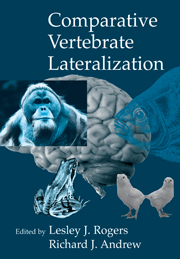Book contents
- Frontmatter
- Contents
- List of Contributors
- Preface
- Introduction
- Part one Evolution of lateralization
- Part two Development of lateralization
- Part three Cognition and lateralization
- 10 Evidence for cerebral lateralization from senses other than vision
- 11 Facing an obstacle: Lateralization of object and spatial cognition
- 12 Laterality of communicative behaviours in non-human primates: A critical analysis
- 13 Specialized processing of primate facial and vocal expressions: Evidence for cerebral asymmetries
- Part four Lateralization and memory
- Epilogue
- Author Index
- Subject Index
- Richard Andrew
13 - Specialized processing of primate facial and vocal expressions: Evidence for cerebral asymmetries
Published online by Cambridge University Press: 10 December 2009
- Frontmatter
- Contents
- List of Contributors
- Preface
- Introduction
- Part one Evolution of lateralization
- Part two Development of lateralization
- Part three Cognition and lateralization
- 10 Evidence for cerebral lateralization from senses other than vision
- 11 Facing an obstacle: Lateralization of object and spatial cognition
- 12 Laterality of communicative behaviours in non-human primates: A critical analysis
- 13 Specialized processing of primate facial and vocal expressions: Evidence for cerebral asymmetries
- Part four Lateralization and memory
- Epilogue
- Author Index
- Subject Index
- Richard Andrew
Summary
Introduction
In a recent review article, Corballis (1998) states that perhaps ‘the major question confronting research on cerebral asymmetry is whether it will survive into the new millennium’. This volume certainly shows that the field has a strong basis, and that the contributions emerging from studies of animals are providing an increasingly precise picture of how cerebral asymmetries have evolved. Although the field has come a long way since the days when humans were considered uniquely lateralized, there are still many gaps in our knowledge. In this chapter, we attempt to fill in a portion of this gap, focusing explicitly on the non-human primates (hereafter referred to as ‘primates’) and the specialized mechanisms underlying the production and perception of their facial and vocal expressions.
We begin our review by discussing the logic underlying the search for neural specializations, and then briefly discuss a selective set of problems associated with the comparative method. We then discuss current evidence for specialized processing mechanisms, focusing on the perception of faces and facial expressions, the perception of vocalizations, and the production of facial and vocal expressions. We conclude the chapter with a few comments on how future studies of hemispheric specialization must integrate behavioural studies of wild and captive animals with laboratory studies of neurophysiology.
Why Should We Expect Neural Specializations?
Like other species, including humans, it seems reasonable to expect primates to have a suite of specialized brain structures dedicated to processing ethologically relevant behaviours.
- Type
- Chapter
- Information
- Comparative Vertebrate Lateralization , pp. 480 - 530Publisher: Cambridge University PressPrint publication year: 2002
- 8
- Cited by



